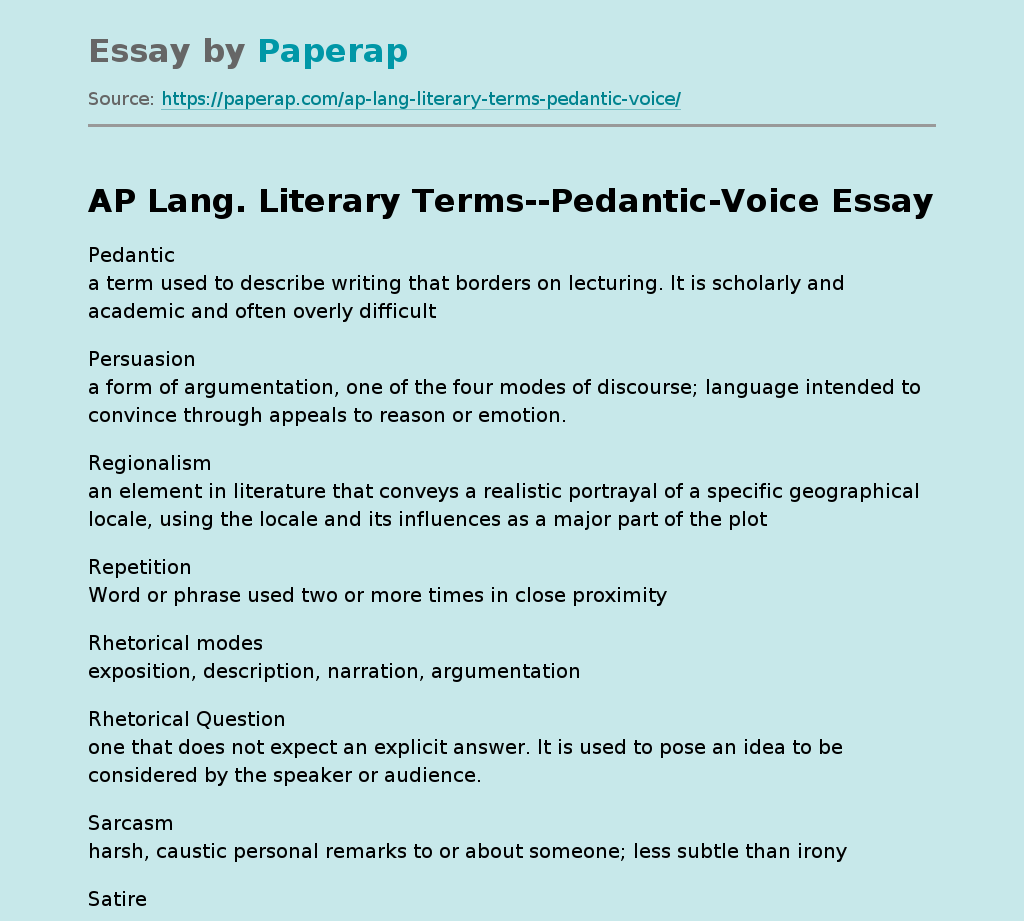AP Lang. Literary Terms--Pedantic-Voice
Essay,
Pages 3 (557 words)
Views
27
Pedantic
a term used to describe writing that borders on lecturing. It is scholarly and academic and often overly difficult
Persuasion
a form of argumentation, one of the four modes of discourse; language intended to convince through appeals to reason or emotion.
Regionalism
an element in literature that conveys a realistic portrayal of a specific geographical locale, using the locale and its influences as a major part of the plot
Repetition
Word or phrase used two or more times in close proximity
Rhetorical modes
exposition, description, narration, argumentation
Rhetorical Question
one that does not expect an explicit answer.
It is used to pose an idea to be considered by the speaker or audience.
Sarcasm
harsh, caustic personal remarks to or about someone; less subtle than irony
Satire
a work that reveals a critical attitude toward some element of human behavior by portraying it in an extreme way. Satire doesn’t simply abuse (as in invective) or get personal (as in sarcasm).
Satire targets groups or large concepts rather than individuals.
Speaker
the voice of a work; an author may speak as himself or herself or as a fictitious persona
Stereotype
a character who represents a trait that is usually attributed to a particular social or racial group and who lacks individuality; a conventional patter, expression or idea.
Style
an author’s characteristic manner of expression–his or her diction, syntax, imagery, structure, and content all contribute to style
Subjectivity
a personal presentation of events and characters, influenced by the author’s feelings opinions
Syllogism
A form of reasoning in which two statements are made and a conclusion is drawn from them.
A syllogism is the format of a formal argument that consists of a major premise, a minor premise, and a conclusion.
Example:
Major Premise: All tragedies end unhappily
Minor Premise: Hamlet is a tragedy
Conclusion: Therefore, Hamlet ends unhappily.
Synecdoche
a figure of speech in which a part of something is used to represent a whole, such as using “boards” to mean a stage or “wheels” to mean a car–or “All hands on deck.”
Syntactic Fluency
ability to create a variety of sentence structures, appropriately complex and/or simple and varied in length
Syntactic Permutation
sentence structures that are extraordinarily complex and involved. They are often difficult for a reader to follow.
Syntax
the grammatical structure of a sentence; the arrangement of words in a sentence. Syntax includes length of sentence, kinds of sentences (questions, exclamations, declarative sentences, rhetorical questions, simple, complex, or compound)
Theme
the central idea or “message” or a literary work
Thesis
the main idea of a piece of writing. It presents the author’s assertion or claim. The effectiveness of a presentation is often based on how well the writer presents, develops, and supports the thesis.
Tone
the characteristic emotion or attitude of an author toward the characters, subject, and audience (anger, sarcastic, loving, didactic, emotional, etc.)
Transition
a word or phrase that links one idea to the next and carries the reader from sentence to sentence, paragraph to paragraph
Understatement
the opposite of exaggeration. It is a technique for developing irony and/or humor where on writes or says less than intended.
Voice
refers to two different ahead of writing. One refers to the relationship between the sentence’s subject and verb (active and passive voice). The second refers to the total “sound” of a writer’s style.
AP Lang. Literary Terms--Pedantic-Voice. (2019, Feb 18). Retrieved from https://paperap.com/ap-lang-literary-terms-pedantic-voice/

